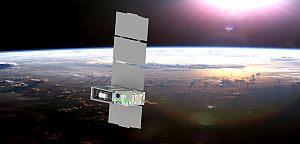NASA Launches Mini Satellites to Explore Exoplanets

Small but mighty
CUTE is the first NASA-funded CubeSat mission to take a look at distant worlds beyond our solar system - an important test of what these small spacecraft might be capable of. "The spacecraft, which costs about four million euros and is a much smaller type of satellite than usual, also known as a CubeSat, is about the size of a shoebox," said IMF Group Leader Luca Fossati, who is a member of the CUTE Science Team. Unlike larger space missions, which often cost hundreds of millions of euros, CubeSats can be produced cheaply and more quickly and still be of scientific use.
Hot worlds in sight
The mini-satellite has big scientific goals: Over the course of about seven months, it will target the 'volatile' physics around a series of exoplanets known as 'hot Jupiters.' As their name suggests, these gaseous planets are both large and scaldingly hot, reaching temperatures of thousands of degrees Celsius. "Thanks to the results, we will better understand how these and many other planets evolve and even shrink over billions of years," Fossati says, explaining the mission goal.
High-tech shoebox
CUTE measures 30x20x10 centimeters, roughly the size of a shoebox. The CubeSat will explore the planets' upper atmospheres using ultraviolet spectroscopy and observe the target objects during a so-called planetary transit: "When the planet passes in front of the star as seen from Earth, some of the starlight manages to penetrate the planet's atmosphere and leave a characteristic signature in the stellar spectrum," Fossati explains. These spectra, captured by CUTE, will be used for closer observations of the atmosphere to better understand planetary mass loss.
Countdown to launch
CUTE will launch along with the Landsat 9 mission from Vandenberg Space Force Base in California. The expected date is Monday, September 27, 2021, 20:10 CEST. In the upper stage of an Atlas V rocket, three other CubeSats are mounted on an adapter ring below the two-ton main payload in addition to the CUTE satellite, which weighs only 10 kilograms. After the separation of Landsat 9, the four CubeSats will be jettisoned about an hour later and placed in orbit.
International cooperation
CUTE was designed and built at the Laboratory for Atmospheric and Space Physics (LASP) at the University of Colorado in Boulder, USA. IMF provided the optical system analysis and supplied the data simulator and data reduction pipeline. The Austrian contribution to CUTE was funded by the Austrian Research Promotion Agency (FFG). Other project partners on the CUTE team are from Arizona, Ireland, France and the Netherlands.
KELT-9b - One of the most exciting targets
CUTE addresses a particularly hot topic in astrophysics. Hot Jupiters and their even more chaotic cousins, the ultra-hot Jupiters, are an extremely inhospitable class of gas worlds. Take KELT-9b: This planet, located in a star system about 670 light-years from ours, has a mass nearly three times that of Jupiter. But KELT-9b also orbits much closer to its parent star - so close that temperatures on the planet reach a staggering 7,800 degrees Celsius. "Because of its proximity to its star, which is nearly twice as hot as our sun, KELT-9b receives an enormous amount of radiation," Fossati reports. Over time, this radiation takes its toll on the planets. At these temperatures, the atmospheres of hot Jupiters begin to expand like a blowfish. They can even rupture and escape into space. And that's where CUTE comes in: the satellite will study the inflated atmospheres of these really hot, fairly gassy exoplanets and measure how quickly the gases escape. This will be accomplished with the help of its unique rectangular telescope design.
From hot Jupiters back to Earth
"The results will be able to tell us a lot not only about hot Jupiters, but about the full range of planets that exist in the galaxy," Fossati said. That includes small and rocky worlds like Earth and its near neighbors. Mars, for example, has also lost much of its atmosphere over nearly three billion years, making the planet uninhabitable for humans.
CUTE is expected to sample as many hot Jupiters as possible during its short lifetime. "The satellite will prove that even 'cute' things can do remarkable science," Fossati is convinced. "Ultimately, the little spacecraft will help clarify Earth's place in the galaxy."
Scientific Contact
Doz. Luca Fossati
T +43 316 4120-601
M +43 676 3386700
luca.fossati@oeaw.ac.at
